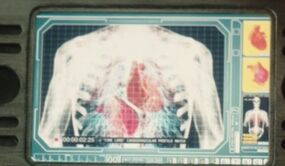Binary vascular system: Difference between revisions
No edit summary |
|||
| Line 9: | Line 9: | ||
In general, binary vascular systems were not common amongst near-Humans. | In general, binary vascular systems were not common amongst near-Humans. | ||
* [[Gallifreyan]]s were perhaps the most notable species known to possess a binary vascular systems. ([[TV]]: ''[[Spearhead from Space]]'', ''[[Inferno (TV story)|Inferno]]'', ''[[Robot (TV story)|Robot]]'', ''[[Doctor Who (TV story)|Doctor Who]]'', ''[[Dalek (TV story)|Dalek]]'', ''[[The Christmas Invasion]]'', ''[[Smith and Jones]]'', ''[[Human Nature (TV story)|Human Nature]]'', ''[[The Power of Three]]'') Being a version of the Time Lords from an alternate timeline, the [[Word Lord]]s also had a binary vascular system. ([[AUDIO]]: ''[[The Word Lord (audio story)|The Word Lord]]'') | * [[Gallifreyan]]s were perhaps the most notable species known to possess a binary vascular systems. ([[TV]]: ''[[Spearhead from Space]]'', ''[[Inferno (TV story)|Inferno]]'', ''[[Robot (TV story)|Robot]]'', ''[[The Talons of Weng-Chiang]]'' ''[[Doctor Who (TV story)|Doctor Who]]'', ''[[Dalek (TV story)|Dalek]]'', ''[[The Christmas Invasion]]'', ''[[Smith and Jones]]'', ''[[Human Nature (TV story)|Human Nature]]'', ''[[The Power of Three]]'') Being a version of the Time Lords from an alternate timeline, the [[Word Lord]]s also had a binary vascular system. ([[AUDIO]]: ''[[The Word Lord (audio story)|The Word Lord]]'') | ||
* In the [[Mutter's Spiral]] [[galaxy]], a few [[monopod]] species and a drone species had two hearts. ([[PROSE]]: ''[[Tragedy Day (novel)|Tragedy Day]]'') | * In the [[Mutter's Spiral]] [[galaxy]], a few [[monopod]] species and a drone species had two hearts. ([[PROSE]]: ''[[Tragedy Day (novel)|Tragedy Day]]'') | ||
* [[Second Doctor|The Doctor]] once encountered another double-hearted [[near-Human]] species called the [[Dulcian]]s. ([[TV]]: ''[[The Dominators]]'') | * [[Second Doctor|The Doctor]] once encountered another double-hearted [[near-Human]] species called the [[Dulcian]]s. ([[TV]]: ''[[The Dominators]]'') | ||
Revision as of 14:39, 16 March 2013
A binary vascular system was a type of circulatory system in which the blood vessels lead to two hearts.
Chen-7, also known as the 1 Day Plague, only affected species with binary vascular systems, such as Apalapucians and Gallifreyans. (TV: The Girl Who Waited)
Baris, a fan of the Tenth Doctor, had a second heart fitted to resemble him more. (PROSE: The Doctor Trap)
Species with a Binary Vascular System
In general, binary vascular systems were not common amongst near-Humans.
- Gallifreyans were perhaps the most notable species known to possess a binary vascular systems. (TV: Spearhead from Space, Inferno, Robot, The Talons of Weng-Chiang Doctor Who, Dalek, The Christmas Invasion, Smith and Jones, Human Nature, The Power of Three) Being a version of the Time Lords from an alternate timeline, the Word Lords also had a binary vascular system. (AUDIO: The Word Lord)
- In the Mutter's Spiral galaxy, a few monopod species and a drone species had two hearts. (PROSE: Tragedy Day)
- The Doctor once encountered another double-hearted near-Human species called the Dulcians. (TV: The Dominators)
- Later, he met the Kulan, another race whose overall stamina seemed to be improved over humans by their two hearts. (PROSE: Escape Velocity)
- The Kirithons were genetically engineered by the Panjistri to have two hearts. (PROSE: Timewyrm: Apocalypse)
- The Apalapucians, residents of Apalapucia, had two hearts. (TV: The Girl Who Waited)
- The inhabitants of Skale had two hearts. (PROSE: Parallel 59)
Benefits
The full implications of a binary vascular system were unclear. However, the Dulcian Rago once told Jamie McCrimmon that beings with single hearts were physically weaker than those with two hearts. (TV: The Dominators)
Similarly, when Henry van Statten performed an invasive scan of the Ninth Doctor, he marvelled at the design and enthusiastically announced he was going to patent it. Given van Statten's obsession with superior technology, this suggested that two hearts were, literally, better than one. (TV: Dalek)
A Gallifreyan could survive with only one heart, should the other be punctured or destroyed, though he or she would be weakened greatly. (PROSE: Managra, PROSE: The Adventuress of Henrietta Street, TV: The Shakespeare Code, The Power of Three) However, if the original heart was repeatedly damaged, even after having a regeneration, it would seem the secondary heart would not be able to sustain a Gallifreyan for long; the person in question would die. A defibrillator could be used to get both hearts working again, in this case. (TV: The Power of Three)
A Gallifreyan in cardiac arrest would need CPR on both hearts. Otherwise, it would prove ineffective. (TV: Smith and Jones)
A binary vascular system provided some level of protection from attack, in that single-hearted near-Humans failed to aim correctly when attempting a close-range attack. The Fifth Doctor, for instance, was once stabbed in the chest, but survived because his human attacker aimed for the spot where the human heart would be. Because the Doctor's two hearts were in a slightly different location, the attack was ineffectual. (AUDIO: Son of the Dragon)
Hearts and regeneration
A Time Lord's regenerative process was intimately linked to his or her hearts. Some accounts held that Time Lords had only one heart until they regenerated for the first time. (PROSE: The Man in the Velvet Mask) Equally, regeneration could be completely stopped — and the Time Lord therefore killed — if both hearts were pierced simultaneously. Andred, for example, died in this way. (AUDIO: Imperiatrix)

